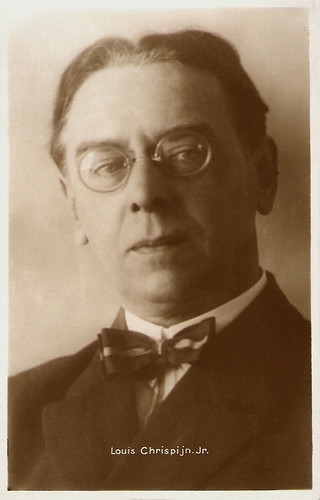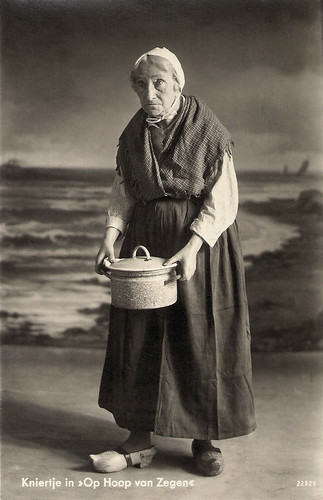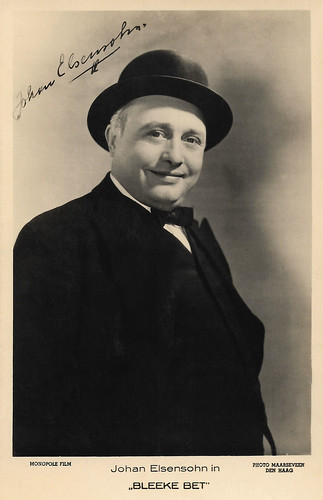Jan van Dommelen (1878-1942) was a Dutch film actor and director of the silent era. He appeared in 44 films between 1911 and 1939.

Dutch postcard by E & B. Photo: HAP Film / Bens Film, Den Haag. Jan van Dommelen in Schakels/Connections (Maurits Binger, 1920), based on a play by Herman Heijermans. Jan van Dommelen plays in Schakels/Connections a blacksmith called Pancras Duif (Dove), who struggles to raise his family. After 25 years, he is old and widower and has managed to raise a successful business, now run by his son Henry (Adelqui Migliar). His other son Tony (Frits Bouwmeester), however, who is a spendthrift, disagrees with his father's new relationship with his maid Marian (Annie Bos), so he tries to blacken her name. Schakels is a lost film.

Dutch postcard by E & B. Photo: Annie Bos in Toffe jongens onder de mobilisatie (deel 1)/Cool boys under the mobilisation (part 1) (Jan van Dommelen, 1914). Translation caption: The Coast Guard. My Johnny is here all day on the coast watching, I think he likes a bath, so I'll be in the Coast Guard.
Johannes Sebastianus Engelbertus (Jan) van Dommelen was born in Amsterdam, the Netherlands in 1878. He was the son of prolific actor Carolus Christiaan (Charles) van Dommelen and Anna van Duijl. Of his nine siblings, three others also became well-known actors, Frits van Dommelen (1867-1932), Caroline van Dommelen (1874-1957) and Louis van Dommelen (1885-1970). Jan started to study at the Amsterdam Theatre School in 1891 and after his graduation, he joined the Koninklijke Vereeniging Het Nederlandsch Tooneel (the Royal Dutch Stage Company).
In 1911 he started to appear in silent shorts for Filmfabriek F.A. Nöggerath, like in the drama Ontrouw/Infidelity (Louis Chrispijn Jr., 1911) with his sister Caroline van Dommelen, and De bannelingen/The Exiles (Caroline van Dommelen, Léon Boedels, 1911) about a 19th-century group of nihilists which wants to improve the horrible conditions for prisoners in Russia. Nöggerath's film production collapsed in 1913, but luckily Van Dommelen found employment at the new film studio Hollandia in Haarlem, run by former printer Maurits Binger.
At Hollandia, Jan van Dommelen first played Willem the Silent / William of Orange / William I of the Netherlands in the Dutch silent historical drama Nederland en Oranje aka Oranje en Nederland/The Netherlands and The House of Orange (Louis H. Chrispijn,1913). The film features nineteen short pieces with themes from Dutch national history and was made to celebrate the Dutch Kingdom. Many segments are 'tableau vivants', with much attention to accuracy when it comes to appearance.
For years Van Dommelen was a regular at Hollandia, which would become the most important Dutch film studio of the silent period. He played both a priest and the protagonist's alcoholic father in Silvia Silombra (Louis H. Chrispijn, 1913), starring Julia Cuypers, and a painter in the Far West in Liefde waakt/An Artist's Model (Louis H. Chrispijn, 1914) starring Annie Bos.
Other titles were Krates (Louis H. Chrispijn, 1913), Zijn viool/De Stradivarius/His Violin (Maurits Binger, 1914) starring violin player Boris Lensky, De bloemen die de ziel vertroosten/The flowers which comfort the soul (Louis H. Chrispijn, 1914), Heilig recht/Sacred right (Louis H. Chrispijn, 1914), and Luchtkastelen/Castles in the sky (Louis H. Chrispijn, 1914). Most of these films got lost but Weergevonden/Found Again (Louis H. Chrispijn, 1914) with Enny de Leeuwe, has literally been found again. Van Dommelen here performed as a non-Jewish doctor, rejected by the Jewish father (played by director Chrispijn himself). The film was largely shot in old Amsterdam, partly in Haarlem.

Louis Chrispijn Jr. Dutch postcard by Weenenk & Snel, Den Haag. Photo: Willem Coret.

Adelqui Migliar and Annie Bos. Publicity still. Source: Immagine. Nuova Serie N. 16, 1990-1991.
Jan van Dommelen also directed films, like the silent comedy Toffe Jongens onder de Mobilisatie/Cool Boys under the Mobilisation (Jan van Dommelen, 1914) starring Annie Bos, and referring to the mobilisation during the First World War. One of his biggest films was De Vloek van het Testament/The Fatal Woman (Maurits Binger, Louis H. Chrispijn, 1914) about a testimony found in an old wooden desk. It even was shown in the US.
Another ambitious Hollandia production was the crime film Het geheim van den vuurtoren/The Secret of the Lighthouse (Maurits Binger, 1916) which was also sold to France, where it was titled Le Secret du Phare. It was a large-scale project because it required the construction of a 20-meter-high ruined lighthouse and a 15-metre-long pier on the coast of Zandvoort. The film starred such famous Dutch actors as Willem van der Veer, Annie Bos and Coen Hissink.
Other Hollandia productions in which Jan van Dommelen appeared were the - still surviving - drama Het geheim van Delft/The Secret of Delft (Maurits Binger, 1917) with Annie Bos and Lily Bouwmeester, Madame Pinkette & Co (Maurits Binger, 1917) with Bos and Adelqui Migliar, and De Kroon der Schande/The Crown of Shame (Maurits Binger, 1918) with Willem van der Veer.
He also appeared in the silent film adaptation of the classic play Op hoop van zegen/The Good Hope (Maurits Binger, 1918) starring Esther de Boer-van Rijk and Annie Bos.
He also competed with Adelqui Migliar for the love of Carmen (Annie Bos) in the romantic drama Een Carmen van het Noorden/A Carmen of the North (Maurits Binger, Hans Nesna, 1919). This film survives too and has been shown with newly made scores. The film is considered one of the best silent Dutch films, which is why it is part of the Canon of Dutch Films, established in 2007, and consists of 16 films. In 2009 a remake of the film was made by Jelle Nesna, grandson of Hans Nesna. The film is a hip-hop version of the original film and stars Tycho Gernandt. From the version with Van Dommelen, only an American export version still exists, so it has a happy end.

Esther de Boer-van Rijk in her Kniertje costume for Op hoop van zegen/The Good Hope. Dutch postcard by Foto-Industrie De Voorkeur, Amsterdam, no 22927. Photo: Leenheer.

Publicity still. Adelqui Migliar and Annie Bos in Een Carmen van het Noorden/A Carmen of the North (Maurits Binger, Hans Nesna, 1919). Source: Immagine. Nuova Serie N. 16, 1990-1991.
Jan van Dommelen played the lead role in Schakels/Connections (Maurits Binger, 1920) based on a play by Herman Heijermans. He had a small part in the British-Dutch coproduction Bulldog Drummond (Oscar Apfel, 1922), the first film adaptation of the Bulldog Drummond fictional character, produced by Maurits Binger.
He then played Beth’s husband in the folk drama Bleeke Bet/Pale Beth (Alex Benno, 1923) featuring Alida van Gijtenbeek as Beth, and also with Beppie de Vries, Heintje Davids and Johan Elsensohn.
Arnoud Tiele at IMDb: “In 1927 he funded an experimental sound film out of his own pocket, Het heksenlied/Witch Song. The idea was to let an orchestra play, while Van Dommelen recited his text from behind the curtains, while the film images rolled. The experiment failed because, in the meantime, ordinary sound films were already produced. The sound film meant virtually the end for the career of Jan van Dommelen”.
After the introduction of sound film, he only appeared in minor parts in films like the comedy De Familie van mijn Vrouw/My Wife's Family (Jaap Speijer, 1935) starring Johan Kaart, the military comedy De Big van het Regiment/The Mascot of the Company (Max Nosseck, 1937) with Frits van Dongen, and finally Boefje/Wilton's Zoo (Detlef Sierck a.k.a. Douglas Sirk, 1939) featuring Annie van Ees.
Jan van Dommelen died in 1942 in Santpoort, the Netherlands. He was 64. He had been married twice. From 1904 to 1910 he was married to Margaretha Josina Josephine Anjelier with whom he had a daughter. In 1918 he married Johanna de Vries. They stayed together till his death and had two children.

Johan Elsensohn. Dutch postcard by M.B. & Z. (M. Bonnist & Zonen, Amsterdam). Photo: Dick van Maarseveen, Den Haag / Monopole Film. Publicity still for the sound version of Bleeke Bet (1934). Collection: Geoffrey Donaldson Institute.

Johan Kaart Jr. in the Dutch comedy De familie van mijn vrouw/My Wife's Family (Jaap Speyer, 1935). Dutch postcard. M.B. & Z. Photo: Loet C. Barnstijn Productie.
Sources: Geoffrey Donaldson (Historici.nl - Dutch), Arnoud Tiele (IMDb), Film in Nederland (Dutch - now defunct), Wikipedia (English and Dutch) and IMDb.
This post was last updated on 16 January 2024.

Dutch postcard by E & B. Photo: HAP Film / Bens Film, Den Haag. Jan van Dommelen in Schakels/Connections (Maurits Binger, 1920), based on a play by Herman Heijermans. Jan van Dommelen plays in Schakels/Connections a blacksmith called Pancras Duif (Dove), who struggles to raise his family. After 25 years, he is old and widower and has managed to raise a successful business, now run by his son Henry (Adelqui Migliar). His other son Tony (Frits Bouwmeester), however, who is a spendthrift, disagrees with his father's new relationship with his maid Marian (Annie Bos), so he tries to blacken her name. Schakels is a lost film.

Dutch postcard by E & B. Photo: Annie Bos in Toffe jongens onder de mobilisatie (deel 1)/Cool boys under the mobilisation (part 1) (Jan van Dommelen, 1914). Translation caption: The Coast Guard. My Johnny is here all day on the coast watching, I think he likes a bath, so I'll be in the Coast Guard.
Nihilists
Johannes Sebastianus Engelbertus (Jan) van Dommelen was born in Amsterdam, the Netherlands in 1878. He was the son of prolific actor Carolus Christiaan (Charles) van Dommelen and Anna van Duijl. Of his nine siblings, three others also became well-known actors, Frits van Dommelen (1867-1932), Caroline van Dommelen (1874-1957) and Louis van Dommelen (1885-1970). Jan started to study at the Amsterdam Theatre School in 1891 and after his graduation, he joined the Koninklijke Vereeniging Het Nederlandsch Tooneel (the Royal Dutch Stage Company).
In 1911 he started to appear in silent shorts for Filmfabriek F.A. Nöggerath, like in the drama Ontrouw/Infidelity (Louis Chrispijn Jr., 1911) with his sister Caroline van Dommelen, and De bannelingen/The Exiles (Caroline van Dommelen, Léon Boedels, 1911) about a 19th-century group of nihilists which wants to improve the horrible conditions for prisoners in Russia. Nöggerath's film production collapsed in 1913, but luckily Van Dommelen found employment at the new film studio Hollandia in Haarlem, run by former printer Maurits Binger.
At Hollandia, Jan van Dommelen first played Willem the Silent / William of Orange / William I of the Netherlands in the Dutch silent historical drama Nederland en Oranje aka Oranje en Nederland/The Netherlands and The House of Orange (Louis H. Chrispijn,1913). The film features nineteen short pieces with themes from Dutch national history and was made to celebrate the Dutch Kingdom. Many segments are 'tableau vivants', with much attention to accuracy when it comes to appearance.
For years Van Dommelen was a regular at Hollandia, which would become the most important Dutch film studio of the silent period. He played both a priest and the protagonist's alcoholic father in Silvia Silombra (Louis H. Chrispijn, 1913), starring Julia Cuypers, and a painter in the Far West in Liefde waakt/An Artist's Model (Louis H. Chrispijn, 1914) starring Annie Bos.
Other titles were Krates (Louis H. Chrispijn, 1913), Zijn viool/De Stradivarius/His Violin (Maurits Binger, 1914) starring violin player Boris Lensky, De bloemen die de ziel vertroosten/The flowers which comfort the soul (Louis H. Chrispijn, 1914), Heilig recht/Sacred right (Louis H. Chrispijn, 1914), and Luchtkastelen/Castles in the sky (Louis H. Chrispijn, 1914). Most of these films got lost but Weergevonden/Found Again (Louis H. Chrispijn, 1914) with Enny de Leeuwe, has literally been found again. Van Dommelen here performed as a non-Jewish doctor, rejected by the Jewish father (played by director Chrispijn himself). The film was largely shot in old Amsterdam, partly in Haarlem.

Louis Chrispijn Jr. Dutch postcard by Weenenk & Snel, Den Haag. Photo: Willem Coret.

Adelqui Migliar and Annie Bos. Publicity still. Source: Immagine. Nuova Serie N. 16, 1990-1991.
Large-scale project
Jan van Dommelen also directed films, like the silent comedy Toffe Jongens onder de Mobilisatie/Cool Boys under the Mobilisation (Jan van Dommelen, 1914) starring Annie Bos, and referring to the mobilisation during the First World War. One of his biggest films was De Vloek van het Testament/The Fatal Woman (Maurits Binger, Louis H. Chrispijn, 1914) about a testimony found in an old wooden desk. It even was shown in the US.
Another ambitious Hollandia production was the crime film Het geheim van den vuurtoren/The Secret of the Lighthouse (Maurits Binger, 1916) which was also sold to France, where it was titled Le Secret du Phare. It was a large-scale project because it required the construction of a 20-meter-high ruined lighthouse and a 15-metre-long pier on the coast of Zandvoort. The film starred such famous Dutch actors as Willem van der Veer, Annie Bos and Coen Hissink.
Other Hollandia productions in which Jan van Dommelen appeared were the - still surviving - drama Het geheim van Delft/The Secret of Delft (Maurits Binger, 1917) with Annie Bos and Lily Bouwmeester, Madame Pinkette & Co (Maurits Binger, 1917) with Bos and Adelqui Migliar, and De Kroon der Schande/The Crown of Shame (Maurits Binger, 1918) with Willem van der Veer.
He also appeared in the silent film adaptation of the classic play Op hoop van zegen/The Good Hope (Maurits Binger, 1918) starring Esther de Boer-van Rijk and Annie Bos.
He also competed with Adelqui Migliar for the love of Carmen (Annie Bos) in the romantic drama Een Carmen van het Noorden/A Carmen of the North (Maurits Binger, Hans Nesna, 1919). This film survives too and has been shown with newly made scores. The film is considered one of the best silent Dutch films, which is why it is part of the Canon of Dutch Films, established in 2007, and consists of 16 films. In 2009 a remake of the film was made by Jelle Nesna, grandson of Hans Nesna. The film is a hip-hop version of the original film and stars Tycho Gernandt. From the version with Van Dommelen, only an American export version still exists, so it has a happy end.

Esther de Boer-van Rijk in her Kniertje costume for Op hoop van zegen/The Good Hope. Dutch postcard by Foto-Industrie De Voorkeur, Amsterdam, no 22927. Photo: Leenheer.

Publicity still. Adelqui Migliar and Annie Bos in Een Carmen van het Noorden/A Carmen of the North (Maurits Binger, Hans Nesna, 1919). Source: Immagine. Nuova Serie N. 16, 1990-1991.
Bulldog Drummond
Jan van Dommelen played the lead role in Schakels/Connections (Maurits Binger, 1920) based on a play by Herman Heijermans. He had a small part in the British-Dutch coproduction Bulldog Drummond (Oscar Apfel, 1922), the first film adaptation of the Bulldog Drummond fictional character, produced by Maurits Binger.
He then played Beth’s husband in the folk drama Bleeke Bet/Pale Beth (Alex Benno, 1923) featuring Alida van Gijtenbeek as Beth, and also with Beppie de Vries, Heintje Davids and Johan Elsensohn.
Arnoud Tiele at IMDb: “In 1927 he funded an experimental sound film out of his own pocket, Het heksenlied/Witch Song. The idea was to let an orchestra play, while Van Dommelen recited his text from behind the curtains, while the film images rolled. The experiment failed because, in the meantime, ordinary sound films were already produced. The sound film meant virtually the end for the career of Jan van Dommelen”.
After the introduction of sound film, he only appeared in minor parts in films like the comedy De Familie van mijn Vrouw/My Wife's Family (Jaap Speijer, 1935) starring Johan Kaart, the military comedy De Big van het Regiment/The Mascot of the Company (Max Nosseck, 1937) with Frits van Dongen, and finally Boefje/Wilton's Zoo (Detlef Sierck a.k.a. Douglas Sirk, 1939) featuring Annie van Ees.
Jan van Dommelen died in 1942 in Santpoort, the Netherlands. He was 64. He had been married twice. From 1904 to 1910 he was married to Margaretha Josina Josephine Anjelier with whom he had a daughter. In 1918 he married Johanna de Vries. They stayed together till his death and had two children.

Johan Elsensohn. Dutch postcard by M.B. & Z. (M. Bonnist & Zonen, Amsterdam). Photo: Dick van Maarseveen, Den Haag / Monopole Film. Publicity still for the sound version of Bleeke Bet (1934). Collection: Geoffrey Donaldson Institute.

Johan Kaart Jr. in the Dutch comedy De familie van mijn vrouw/My Wife's Family (Jaap Speyer, 1935). Dutch postcard. M.B. & Z. Photo: Loet C. Barnstijn Productie.
Sources: Geoffrey Donaldson (Historici.nl - Dutch), Arnoud Tiele (IMDb), Film in Nederland (Dutch - now defunct), Wikipedia (English and Dutch) and IMDb.
This post was last updated on 16 January 2024.
No comments:
Post a Comment